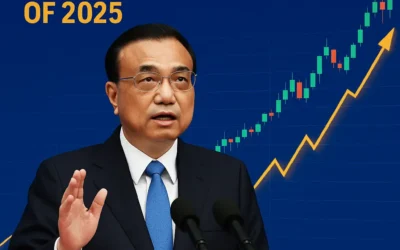China, the world’s second-largest economy, enters 2025 with an audacious plan. Its China 2025 economic strategy—aiming for 5% growth, tech independence, and massive stimulus—shows unstoppable drive. Yet, dire challenges like U.S. tariffs, weak demand, and rising debt threaten success. This post explores the China 2025 economic strategy, using data from the World Bank, Bloomberg, and China Briefing.

China 2025 Economic Strategy: A Stunning but Fragile Start
China began 2025 with stunning growth. Its GDP rose 5.4% in Q1, beating forecasts due to strong exports and output. Retail sales grew, hinting at consumer recovery. Yet, analysts warn growth may fall to 3.4% if U.S. tariffs hit. In March 2025, Beijing set a bold 5% goal and raised the fiscal deficit to 4%.
However, crucial weaknesses loom. Low demand and U.S. trade tensions pose risks. Also, China’s reliance on exports is fading. It needs consumer-led growth. Hence, the China 2025 economic strategy is a fragile balance. See global trade trends or consumer demand shifts for context.
Fiscal Firepower: An Audacious Stimulus Surge
To hit 5% growth, China is using massive stimulus. It plans a RMB 6 trillion debt increase. Of this, RMB 4 trillion funds 2024–2028 budgets. Another RMB 2 trillion is for quick relief. Beijing will fund banks with ¥500 billion to boost lending. In May 2025, the central bank cut rates and added $138.5 billion to ease trade war strain.
Critics question this surge. Adding money to a low-demand economy may fail. Inflation, targeted at 2%, could rise. So, China’s transformative stimulus helps now but risks debt and delays consumer growth. This balance is urgent. See stimulus effects or inflation risks for more.
Tech Sovereignty: “Made in China 2025” Epic Vision
At the core of the China 2025 economic strategy is “Made in China 2025.” This plan seeks 70% tech independence by 2025. A U.S. Chamber of Commerce study shows it cut foreign tech reliance. Beijing aims at AI, chips, and green energy to lead globally by 2049.
Yet, this sparks alarm. The U.S. sees it as a trade threat, raising tariffs. At home, state-led tech spending may hurt private firms and add debt. Thus, “Made in China 2025” is epic but perilous. It fuels global tension. Read about tech rivalry for context.
Major Risks: Crucial Threats to China’s 2025 Strategy
- Trade Wars: U.S. tariffs could cut GDP by 0.6%.
- Weak Demand: Low consumer confidence slows consumer growth.
- Debt Risks: More deficits and bank funding raise debt.
- Global Tensions: Pushback on tech policies may disrupt supply chains.
Analysts call this an “unstoppable tightrope walk”—audacious but shaky. If demand and trade issues persist, the 5% goal is at risk. Moreover, debt and geopolitical backlash could destabilize growth. Explore debt risks for insight.
Outlook: China 2025 Economic Strategy Faces Perilous Stakes
In 2025, the China 2025 economic strategy seeks growth and tech dominance. Massive stimulus, bank funding, and “Made in China 2025” show irresistible drive. But trade wars, weak demand, and debt loom large. A top official cited “crucial challenges” from global unrest. China’s economy is strong yet fragile, audacious yet perilous.
If successful, China could reshape global markets. If mismanaged, it risks stagflation or financial strain. What to watch: consumer spending, tech breakthroughs, and trade tensions. For now, the China 2025 economic strategy is a high-stakes gamble.
For more on the China 2025 economic strategy, visit the World Bank, Bloomberg, or China Briefing. Stay updated on this critical story.
Final Thoughts
The China 2025 economic strategy is audacious but not reckless—a calculated push for dominance amid fierce competition. The road is perilous, but China’s adaptable, state-driven model may navigate it. What do you think? Will China’s strategy triumph, or will global pressures derail it? Share your views below! 🚀









0 Comments